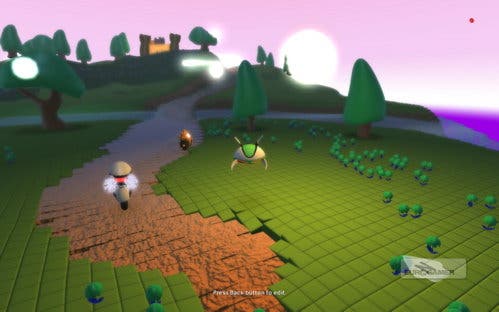Kodu Game Lab
One I made earlier.
For example, you might create the line: When 'player holds down L trigger' then 'shoot' + 'missile' + 'of a random colour' + 'forward' + 'once'. It's then possible to adjust the speed and rate of fire of your missiles or the speed of your vehicle and so on. In minutes you can choose to make it invulnerable, have the HUD display its hit-points, set its bounciness, friction, how many missiles can appear on screen at any one time, and so on. It's fast, straightforward and, in most cases, everything behaves in exactly the way you would expect it to.
As this is an XNA game, don't expect a huge amount of polish to the tutorials. Everything is rough and ready in terms of presentation, but it's also been thoughtfully arranged so that you soon learn the basics and, if ever you do become lost, it doesn't take long to find your way back to the top level of the editing menus. As well as the 11 rudimentary learn-as-you-do tutorials, Kodu comes with a slew of example levels and game types, all of which can be tweaked and picked apart so you can see how they work. It's worth spending time with all of these before embarking on your own first blank project as, until you have a good handle on the basics, an empty 3D space waiting to be filled with cameras, textures, objects and ideas can be a terrifying prospect.
However, when you are ready to start on something from scratch, the options are pleasingly varied. You can add scores of different characters and objects to your world and, while there's no graphical editor to allow you to design these from scratch, stock items include things as varied as walls, roads, apples, fish, jets, blimps, submarines, cannons, clouds, stars, rocks, coins, castles, hearts and ammo. Adding ground to your game level is as simple as painting it on, Photoshop-style (from a palette of 121 different types, colours and textures), and you can change the lighting and even adjust the strength of the breeze. You can raise and lower the ground to make hills and valleys, set the camera behaviours, alter wave strength, how the game first appears to users (with a description or a timer counting down), and you even have some rudimentary tools for debugging sight and sound lines, displaying collision data and so on.

While good results will almost certainly take longer than even the most complex LittleBigPlanet level, and it'll only look half as good thanks to the blocky, N64-esque graphics engine, the two games are comparable. As with Media Molecule's title, Kodu will teach you the basics of game design. Maybe not in the sense of hard-coding, but certainly in the process of formulating an idea and then executing all of the various necessary components to bring it to life.
It will take the coming weeks and months for Kodu's boundaries to be pushed against and broken by creative types and through that process some gems may be formed. But my hunch is that Kodu's lasting worth rests not in the creations its users put out, but in the lessons and principles it teaches those users, in the young people that are inspired to become game designers when they grow up, and in the older people who gain a new appreciation for the effort that goes into even the humblest videogame.








